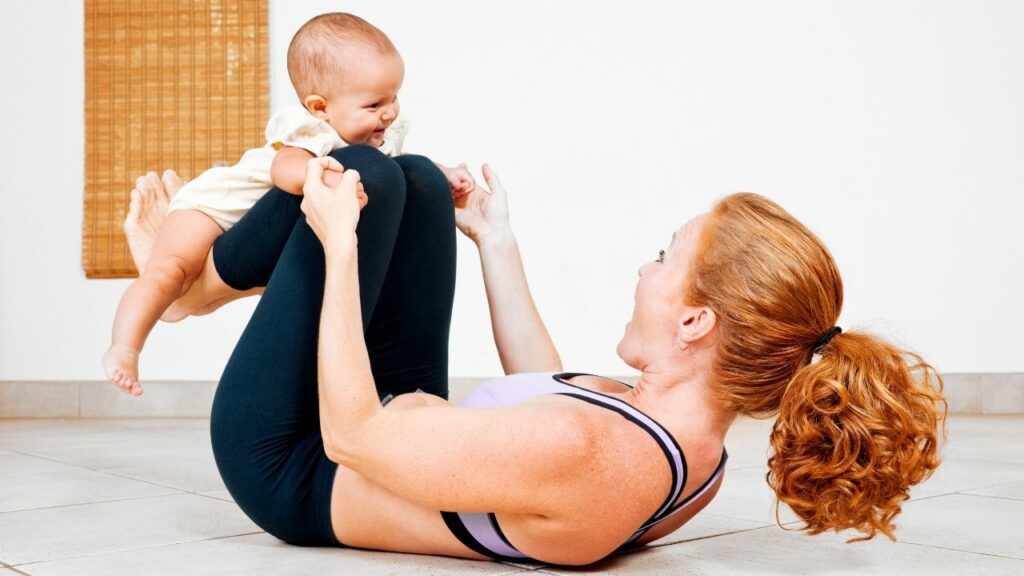The term “mommy pooch” is something many moms are familiar with. How to get rid of one is probably one of the most commonly asked questions I get.
But what exactly is the “Mommy Pooch”?
And why is there so much conflicting information out there about how to get rid of it?
Should you be lifting weights, should you be doing planks, should you be doing crunches? Will any of these help your diastasis recti?
SO.MANY.QUESTIONS.
You’re about to get a crash course lesson about that mommy pooch! We’re going to get a little technical but read through; this is good for your brain…and your belly!
What we call the mommy pooch is often caused by a condition called Diastasis Recti Abdominis (DRA). What looks like loosened belly skin and a bloated belly can be due to changes in pressure distribution in the abdomen”inside your abdomen, called intra-abdominal pressure (IAP). As well as the weakening of the connective tissue between your left and right abdominal muscles.
Diastasis Recti (DRA) and Intra-Abdominal Pressure (IAP) Explained
Let’s cover the basics. During pregnancy or when you gain weight, your abdominals elongate and are stretched outward to accommodate your organs and growing baby. Your muscles separate as a result to make room for the baby. Think of the trunk as a strong house for our organs, the diaphragm forms the ceiling, the pelvic floor forms the floor, and our abdominals and deep back muscles for the walls.
When the abdominals elongate and separate in this manner, the walls of our “organ house” become weaker, which provides less stability for the ceiling and floor. This alters our intra-abdominal pressure (IAP) and can affect the piston-like mechanics of the diaphragm and pelvic floor, which work together to create efficient breathing.
Diastasis Recti occurs in 100% of pregnant women and can continue into the postpartum period in as many as 60% of women (Sperstad 2016).
‘While all women will experience DRA in the final weeks of the third trimester, some movements can make it worse or may make the DRA worse. It has been suggested that heavy lifting during pregnancy may be a factor in having a DRA that has difficulty closing, however, research is still inconclusive. (Sperstad 2016).
In some women, after the baby is born, these muscles have difficulty healing. The two borders of the long muscles, also called rectus abdominis do not return to their former position. This is what’s causing the mommy pooch to be such a big problem.
This leaves room for those organs to protrude in the center of the stomach where the abs are split and unable to hold them in. As a result of stretched out skin and organs, we see the “beloved” mommy pooch.
It is possible for a person who has never been pregnant to have diastasis recti. This is due to other causes of intra-abdominal pressure, such as extra weight, and it sometimes even occurs in newborn infants. But in general, this condition is very common among moms, hence the name the “mommy pooch.”
Problems Diastasis Recti Might Cause
Ladies, you need to make sure you get checked out if you think you could have diastasis recti. If left untreated, diastasis recti can cause these symptoms:
- Incorrect posture
- Back Strain
- Unhealthy breathing
- Loosened skin/bulge in the stomach area
- Midsection weakness
- Sexual pain
Explaining the Abdominal Cavity AKA The Core
Like most things surrounding pregnancy and childbirth, the way to handle Diastasis Recti Abdominis (DRA) is a topic of debate.
It’s so important to understand that there are more abdominal muscles than the rectus abdominis muscles associated with the DRA. There are four abdominal muscles that form layers to protect and stabilize the trunk. Moving from outward in, they are rectus abdominis, the obliques- external obliques and internal obliques, and the deepest layer of abdominals, transverse abdominis.
The abdominals are important in maintaining proper intra-abdominal pressure (IAP), posture and bracing the spine during functional movements as well as when you cough, sneeze, have a bowel movement, and even when you breathe. Restoring the abdominals to their original strength is an important step in the post-birth recovery process.
Furthermore, it is important to note that the abdominal muscles work in symphony with the pelvic floor muscles, diaphragm, and small muscles in the spine called the multifidi. They work together to stabilize the trunk, promote effective breathing, and maintain IAP. The diaphragm and pelvic floor work in a piston-like manner wherein the diaphragm drops drawing breath into the lungs, the pelvic floor also drops. To expel air it is vital that the diaphragm returns to its resting point and the pelvic floor lifts back up. This requires that the muscles maintaining the walls of the trunk are strong and hold form.
What is wrong with crunches?
When considering exercises to rebuild abdominal strength, some people recommend staying away from crunches and sit-ups altogether. Many people think of them as being harmful to already-separated ab muscles. However, the key is, the reason many assume these are unsafe is when proper breathing and abdominal activation technique is not used. Then the exercises are definitely not doing any help and in fact, will probably make your diastasis recti worse. That’s why these exercises get a bad rap in the postpartum-exercise world.
There was some research that showed that curl-ups could be helpful in closing the gap of a DRA. However, when this maneuver was analyzed using ultrasound imaging, the researchers found that while the gap was smaller, the maneuver did not help to stabilize the trunk as well as other exercises. (Lee 2016).
The most common error many women make is in attempting to close a DRA is holding their breath while exercising. This places excessive pressure on the abdominals and spine muscles and can worsen DRA. Additionally, failing to properly engage the deeper abdominal muscles will also be unhelpful in correcting DRA. (Lee 2016).
That being said, with proper breathing and pressure-control techniques, ab exercises can be completely and 100% safe. The important thing is you must learn these techniques well from someone (ahem, ahem…me!!) who specializes in the postpartum body and its unique concerns.
Of course, you should always have a chat with your doctor or physical therapist before beginning any exercises, especially soon after birth.
Techniques to Help Fix the ”Mommy Pooch”
You don’t have to cut sit-ups out of your life, you just have to know how to control IAP and minimize damage. If you are not 100% sure if you are doing it correctly, it is best to avoid it all together… as we talked about previously. Doing it incorrectly will cause more harm than good.
There isn’t a one-size-fits-all exercise for everyone with diastasis recti.
To close a DRA the whole body needs to be adjusted in posture, and the internal core muscles and pelvic floor need to be strengthened. This takes work,!
So, without further ado, here are two important tips to remember when you are ready and have a doctor’s approval to begin doing crunches after diastasis recti. These won’t add intra-abdominal stress on your muscles and are easy to practice in conjunction with breathing correctly:
- Pull Your Stomach In and Up
Gently pulling your stomach in and up helps train your muscles and avoid IAP when you perform crunches. Picture yourself protecting your organs as you do this to remember to sustain itit throughout the exercise.
- Diaphragmatic Breathing
This is another exercise designed to work your inner core muscles, but it simply involves how you breathe.
Check out my video explaining how to do this: https://m.youtube.com/watch?v=XfUjUv_bo8c
In Conclusion
Blog Takeaways
1.The main issue with crunches and sit-ups is that most people do not know how to properly control pressure when doing it.
2. The key is to understand how to breathe properly while doing crunches, and therefore create less IAP.
3. Diastasis Recti is VERY common, so I don’t want you to feel like it is the end of the world.
4. A lot of women are able to reverse their DRA without surgery, just with rehab and by learning to control pressure (IAP) when moving, lifting weights and even sneezing.
Credits
Lee, D., & Hodges, P. W. (2016). The behavior of the linea alba during a curl-up task in diastasis rectus abdominis: an observational study. journal of orthopedic & sports physical therapy, 46(7), 580-589.
Sperstad, J. B., Tennfjord, M. K., Hilde, G., Ellström-Engh, M., & Bø, K. (2016). Diastasis recti abdominis during pregnancy and 12 months after childbirth: prevalence, risk factors and report of lumbopelvic pain. Br J Sports Med, 50(17), 1092-1096.
Wanting to learn more!? No worries. I’ve got you. I created a B-R-A-N-D spanking new eBook and I’m giving it away totally free. Grab your copy of “How to get 6 pack abs after TWO C-Sections. This book is the real deal. I’m diving into why overnight fixes won’t work. I’m sharing secrets that won’t have you spending hours in the gym AND I’m teaching you tricks that don’t involve 1,000 crunches an hour…
P.S. – Are you ready to get Super Shredded this Summer?? Then come join the ’5 Week Super Shred Challenge For a limited time only you can join at the Early Bird pricing!! Hurry and reserve your spot so you can start transforming your body so you can feel more confident and sexy AF this Summer! JOIN NOW
Save this post on Pinterest and follow me for more inspiration.


